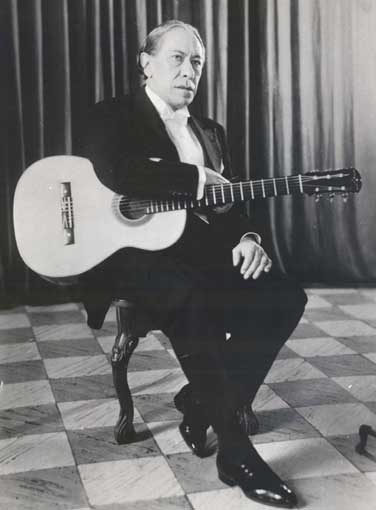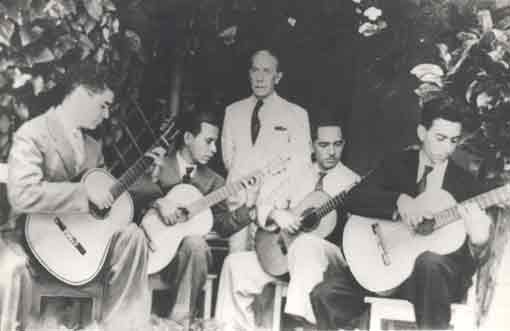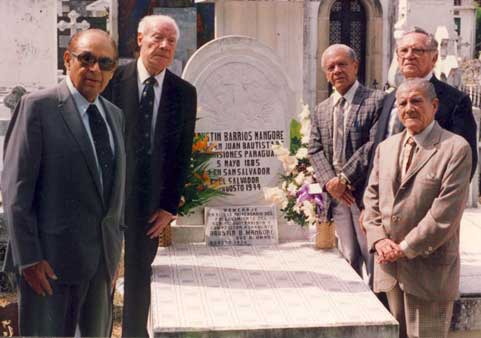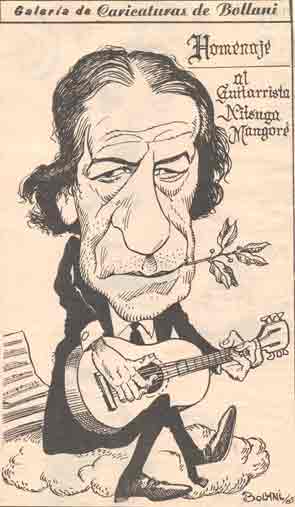Who was Agustín Barrios Mangoré?
Agustín Barrios Mangoré during his career as a master at the El Salvador Conservatory of Music (images courtesy of Carlos Payés).
Agustín Barrios was a singularly gifted guitarist, and his compositions are considered de rigueur in the repertoires of John Williams and other masters of the classical guitar.
This, however, was not always the case.
Barrios was born in Paraguay but left forever as a young man to seek opportunities elsewhere, crisscrossing the Americas and Europe on a lifetime of concert tours.
In his later years he adopted the stage name “Nitsuga Mangoré”, and today he is often referred to simply as Mangoré (“Nitsuga” is his first name spelled backwards, while “Mangoré” was a colonial period leader of the Guaraní people).
Mangoré finally settled in El Salvador where he received the patronage of the Salvadoran government through the end of his years with a position at the El Salvador Conservatory of Music. It was during this time that he mentored a cadre of 12 guitarists, aptly called “Mangoré’s disciples”. The last surviving disciple was Victor Urrutia, who passed away on August 1st, 2010.
Mangoré with four of his disciples in El Salvador.
Mangoré died in 1944 and, as was his express desire, he was buried in the capital city, San Salvador. His tomb is located in a distinguished precinct called the “Cementerio de los Ilustres” and is protected as cultural heritage by two governmental decrees.
After Mangoré’s death in 1944, his legacy persisted only in this small group of students, and seemed destined for oblivion.
Mangoré's tomb in El Salvador with his students (1993).
It remained for a member of the succeeding generation of El Salvador’s guitarists, Carlos Payés, to rediscover the work of Mangoré (we are honored to have Carlos Payés on the board of directors of FUNDAR). Payés worked intensively with Mangoré’s elderly disciples and recovered numerous compositions and other information.
More importantly, Payés, who recognized the unique and inspired nature of Mangoré’s legacy, began in 1969 to distribute his Xeroxes of decades-old scores to John Williams, Alirio Díaz and other top figures of the classical guitar who performed this amazingly fresh music before enraptured audiences.
Simply put, this was the rediscovery of a musical genius.
John Williams plays "La Catedral" (The Cathedral) by Mangoré.
Others followed the pioneering work of Payés to recover more scores and recordings which Mangoré left scattered in several countries. The last 20 years have seen the publication of several books about Mangoré and numerous recordings.
In contrast, in Paraguay, Mangoré was all but forgotten until recent times when his music became widely known. Despite Mangoré’s express desire to be buried in El Salvador, a group of Paraguayans is presently attempting to pressure Salvadoran authorities in order to exhume his remains and “repatriate” them to Paraguay, a country which never gave Mangoré any support. Only now that Mangoré is world famous has Paraguay finally given him due recognition.
Needless to say, the opportunistic "repatriation" of Mangoré's remains would violate the two legal decrees protecting his tomb as well as Mangoré's personal desire to remain in his adopted homeland, El Salvador.
Mangoré in El Salvador by the caricaturist Bollani.




